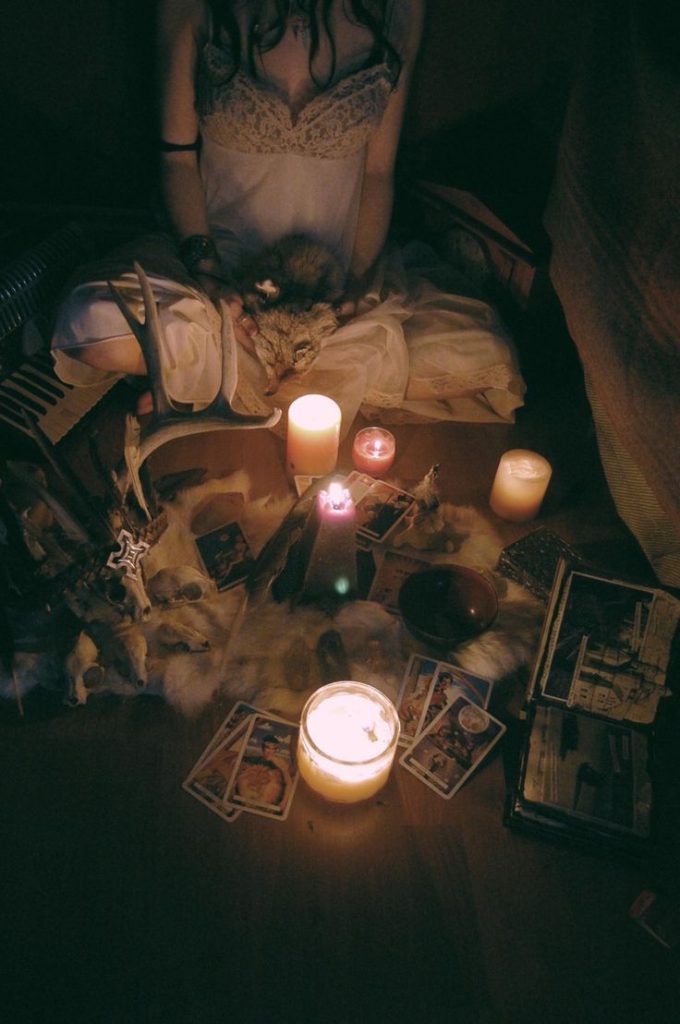The concept of self-humiliation rituals might seem perplexing at first glance. However, delving deeper into the world of witchcraft reveals that self-humiliation holds a unique place within this esoteric tradition, offering practitioners a path of introspection, growth, and connection to their inner selves.
The Paradox of Self-Humiliation Rituals
The paradox of self-humiliation rituals within the context of witchcraft is a concept that brings together seemingly contradictory elements to create a profound and transformative experience. This paradox revolves around the idea that willingly subjecting oneself to feelings of discomfort, vulnerability, or symbolic submission can lead to empowerment, growth, and a deeper connection with one’s spiritual self. Let’s delve deeper into this paradox and explore its significance:
- Breaking Down Ego: The paradox of self-humiliation lies in the notion that by intentionally humbling oneself and confronting personal limitations, practitioners can actually transcend the confines of ego. Ego, in this context, refers to the sense of self that is often driven by pride, attachment, and the desire to maintain a certain image. Self-humiliation rituals encourage practitioners to set aside their ego-driven concerns and open themselves up to authentic self-discovery.
- Embracing Vulnerability: Self-humiliation rituals invite practitioners to embrace vulnerability, a state often shunned in modern society. Paradoxically, it is through vulnerability that individuals can tap into deeper layers of their consciousness, accessing emotions, insights, and aspects of themselves that remain hidden behind protective barriers. By willingly facing vulnerability, practitioners may uncover hidden strengths and inner resilience.
- Cultivating Humility: Humility is a quality highly regarded in many spiritual and philosophical traditions. Self-humiliation rituals challenge practitioners to cultivate humility by acknowledging their imperfections and embracing a more humble perspective. This humility can lead to a greater sense of interconnectedness with the world around them and a heightened awareness of their place in the cosmic order.
- Transcending Comfort Zones: The paradox of self-humiliation also involves stepping out of one’s comfort zones to seek personal growth. By engaging in rituals that intentionally induce discomfort, practitioners push themselves beyond their perceived limits. This expansion of boundaries can lead to enhanced self-confidence and the realization that growth often occurs outside the confines of familiarity.
- Symbolic Transformation: Self-humiliation rituals often involve symbolic acts that represent personal transformation. For example, undergoing a ritual that simulates a form of death and rebirth can symbolize shedding old identities, beliefs, or behaviors. The paradox lies in the fact that by “dying” to one’s old self, practitioners can experience a renewed sense of purpose and a fresh perspective on life.
- Balancing Power Dynamics: Self-humiliation rituals allow practitioners to explore the dynamics of power and control within themselves. By willingly submitting to discomfort or challenges, individuals can gain insights into their relationship with power and authority. This paradoxical process empowers practitioners to redefine their understanding of personal agency and autonomy.
- Deepening Spiritual Connection: Through the paradox of self-humiliation, practitioners may find that intentionally subjecting themselves to discomfort or vulnerability can lead to a deeper connection with the spiritual realm. By surrendering aspects of their ego and embracing humility, practitioners create a receptive space for spiritual insights, guidance, and transformation.
In essence, the paradox of self-humiliation rituals underscores the multidimensional nature of human experience and spiritual growth. While these rituals may initially appear counterintuitive, their true power lies in their ability to challenge, transform, and transcend the limitations of the self


Exploring the Purposes and Intentions of Self-Humiliation
This reveals a fascinating landscape of psychological, spiritual, and transformative significance. These rituals, although seemingly counterintuitive, are rooted in profound intentions that go beyond surface-level discomfort. Let’s delve into the various purposes and intentions behind self-humiliation rituals:
- Personal Transformation: Self-humiliation rituals can serve as a crucible for personal growth and transformation. By deliberately confronting one’s limitations and vulnerabilities, practitioners seek to break down ego barriers and cultivate humility, qualities that are highly regarded in many spiritual traditions.
- Symbolic Rebirth: In some witchcraft practices, self-humiliation may be perceived as a symbolic form of death and rebirth. By willingly undergoing discomfort, practitioners aim to shed old patterns, beliefs, or negative energies, paving the way for a renewed sense of self and a deeper connection to the divine.
- Purification and Cleansing: Similar to other rituals in various spiritual traditions, self-humiliation rituals can be seen as acts of purification. By subjecting oneself to challenges or discomfort, practitioners seek to cleanse their spiritual and emotional selves, ridding them of stagnant energy or perceived impurities.
- Honoring Deities or Spirits: In some witchcraft practices, self-humiliation may be a way of paying homage to deities or spirits. By willingly undergoing trials or demonstrating devotion through acts of humility, practitioners establish a connection with the divine and show their commitment to their beliefs.
Therfore, self-humiliation rituals in witchcraft serve multifaceted purposes and intentions that reach beyond their initial appearance of discomfort. These rituals are vehicles for personal transformation, spiritual connection, and emotional healing. By voluntarily subjecting themselves to vulnerability, practitioners create a space for growth, renewal, and a deeper understanding of themselves and their place within the broader cosmic tapestry. Self-Humiliation Rituals and How to Perform Them
Types of Self-Humiliation Rituals and How to Perform them
Self-humiliation rituals within witchcraft can vary significantly depending on the specific tradition, beliefs, and intentions of practitioners. While these rituals may involve discomfort or symbolic acts of submission, they are often conducted in controlled and intentional settings, prioritizing the well-being and consent of the practitioner. Here are a few examples of self-humiliation rituals and how they might be performed:
- Confession Rituals: In some witchcraft traditions, practitioners may engage in confession rituals where they openly acknowledge and verbalize their perceived shortcomings, mistakes, or negative behaviors. This act of confession can serve as a form of emotional release and purification, allowing practitioners to confront and let go of guilt or shame. How it’s done: The practitioner might create a sacred space, light candles, and use grounding techniques to center themselves. They then speak aloud their confessions, addressing the divine or higher powers, and expressing their intentions to release negative emotions or behaviors. This ritual may conclude with an affirmation of self-forgiveness and a commitment to personal growth.
- Sacrificial Offerings: Some self-humiliation rituals involve making symbolic sacrifices as offerings to deities or spirits. This act is not meant to cause harm but rather to demonstrate dedication and humility. How it’s done: The practitioner may choose an item that holds personal significance or value, such as a cherished possession or a representation of a negative trait. They then ritually offer this item as a symbolic sacrifice, expressing their willingness to let go of attachments and demonstrate their devotion.
- Penance Rituals: Penance rituals focus on self-imposed acts of discipline or penance to atone for perceived wrongdoings. These acts are undertaken as a means of cleansing the spirit and seeking forgiveness. How it’s done: Practitioners might engage in fasting, abstaining from certain pleasures, or performing physical tasks that challenge their endurance. During the ritual, they reflect on their actions and intentions, seeking inner clarity and a sense of emotional release.
- Initiation or Rite of Passage: Some witchcraft traditions incorporate self-humiliation as part of an initiation or rite of passage. These rituals test the dedication and commitment of the practitioner, marking their transition into a new phase of their spiritual journey. How it’s done: Initiates might undergo challenges such as solitary retreats, exposure to the elements, or enduring sensory deprivation. These challenges are designed to push boundaries and facilitate a deeper understanding of oneself and the mysteries of the craft.
- Shadow Work Rituals: Shadow work involves confronting and integrating one’s hidden or repressed aspects. Self-humiliation can be a component of this process, allowing practitioners to explore their darker aspects. How it’s done: Practitioners may create a ritual space and engage in meditation or visualization to connect with their inner shadow. They might then engage in self-reflective practices, such as writing down fears, regrets, or unresolved emotions. This ritual can lead to emotional catharsis and self-acceptance.
It’s important to emphasize that self-humiliation rituals should always be undertaken with care, mindfulness, and a deep understanding of one’s motivations and intentions. Consent, mental and emotional well-being, and personal boundaries must be respected throughout the process. Additionally, not all practitioners incorporate self-humiliation into their witchcraft practices, as it is a highly personal and potentially intense aspect of the craft.


Risks and Precautions Concerning Self-Humiliation Rituals
A. Risks to Consider
Engaging in self-humiliation rituals in witchcraft, while potentially transformative, can also carry certain risks that practitioners should be mindful of. It’s crucial to approach these rituals with a clear understanding of the potential challenges and to prioritize your well-being and mental health. Here are some important risks to consider:
- Emotional Distress: Self-humiliation rituals can evoke intense emotions, including guilt, shame, and anxiety. Deliberately subjecting yourself to discomfort or vulnerability may trigger unresolved emotional issues, leading to emotional distress or exacerbating pre-existing mental health concerns.
- Trauma Triggers: Some self-humiliation rituals might inadvertently trigger traumatic memories or experiences. This can lead to emotional overwhelm and retraumatization, especially if you’re not fully aware of your triggers or if the ritual is not approached with sensitivity.
- Negative Self-Perception: Repeated exposure to self-humiliation can potentially lead to a negative self-image or reinforce feelings of inadequacy. If these rituals are not balanced with self-compassion and self-care, they may have detrimental effects on your self-esteem.
- Physical Harm: Certain self-humiliation practices, such as extreme fasting, excessive physical challenges, or self-inflicted pain, can pose risks to your physical health. Overexertion, dehydration, and self-injury are real concerns that should be taken seriously.
- Ethical Dilemmas: Engaging in self-humiliation rituals without a clear understanding of your intentions or the potential cultural or ethical implications can raise ethical dilemmas. These dilemmas might include issues of cultural appropriation or the potential for self-exploitation.
- Loss of Personal Agency: If self-humiliation rituals become overly rigid or are driven by external pressures, you might lose sight of your personal agency and autonomy. It’s important to ensure that you’re engaging in these rituals by your own choice and not due to external influences or expectations.
- Isolation and Alienation: The pursuit of self-humiliation can sometimes lead to isolation from social connections or a withdrawal from support systems. Isolating yourself during a vulnerable time might hinder your ability to process emotions effectively.
- Spiritual Confusion: Self-humiliation rituals may blur the line between meaningful spiritual practices and self-destructive behaviors. It’s important to differentiate between a transformative ritual and actions that might perpetuate harm.
B. Precautions to Take:
To mitigate these risks, consider the following precautions:
- Self-Awareness: Reflect on your motivations, emotional state, and past experiences before undertaking self-humiliation rituals. Be aware of your triggers and vulnerabilities.
- Moderation: Approach self-humiliation with moderation and balance. Avoid extreme practices that could jeopardize your physical or mental well-being.
- Consent and Boundaries: Ensure that you are fully consenting to the ritual and have a clear understanding of your boundaries. It’s important to have an exit strategy if the ritual becomes overwhelming.
- Support System: Maintain a strong support system of friends, family, or mental health professionals who can provide guidance, validation, and assistance if needed.
- Cultural Awareness: If incorporating elements from specific cultural practices, ensure that you approach them with cultural sensitivity and respect.
- Self-Compassion: Practice self-compassion and self-care before, during, and after the ritual. Focus on nurturing your emotional well-being and processing any difficult emotions that arise.
Remember that self-humiliation is just one approach within the broader landscape of witchcraft and spiritual practice. If you’re uncertain or uncomfortable with the idea of self-humiliation, there are countless other rituals and methods that can lead to personal growth, self-discovery, and spiritual connection.
Modern Interpretations and Variations
Modern interpretations and variations of self-humiliation rituals within the realm of witchcraft reflect the diverse and evolving nature of this ancient practice. As contemporary practitioners engage with the rich tapestry of witchcraft, they bring their own perspectives, beliefs, and ethical considerations to the forefront. In the context of self-humiliation, these interpretations manifest in a range of approaches that acknowledge both the historical roots of such rituals and the evolving sensibilities of the present day.
Some modern practitioners choose to embrace self-humiliation rituals as a means of personal empowerment and inner transformation. They view these rituals as opportunities to challenge societal norms, break free from conventional constraints, and delve into the depths of their own psyche. For these individuals, self-humiliation serves as a form of radical self-exploration, allowing them to confront fears, vulnerabilities, and insecurities head-on, ultimately leading to a strengthened sense of self and purpose.
Conversely, many contemporary witches approach self-humiliation rituals with caution and skepticism, recognizing the potential risks and ethical complexities involved. These practitioners advocate for a more compassionate and nurturing approach to self-discovery, emphasizing self-care and positive affirmations as pathways to personal growth. They may choose to focus on rituals that prioritize self-love, self-acceptance, and self-empowerment, steering clear of practices that could potentially perpetuate harm or reinforce negative self-perceptions.
In the modern witchcraft landscape, there is also a strong emphasis on cultural sensitivity and ethical considerations. Practitioners recognize the importance of respecting cultural traditions and historical contexts when incorporating elements of self-humiliation from different sources. This awareness underscores the need for informed and mindful practice, ensuring that rituals are conducted with a deep understanding of their origins and implications.
Furthermore, the advent of online communities, social media platforms, and interconnected networks has facilitated the exchange of ideas and interpretations. This has led to a dynamic interchange of perspectives on self-humiliation rituals, allowing practitioners to engage in constructive dialogues, share personal experiences, and learn from one another’s insights. As a result, modern interpretations of self-humiliation rituals continue to evolve and adapt, reflecting an ongoing dialogue between tradition and innovation.


Ethical Concerns
Ethical concerns surrounding self-humiliation rituals in witchcraft center on the careful navigation of boundaries, cultural sensitivity, and the potential for unintended harm. Practitioners must consider the origins and historical context of the rituals they engage in, avoiding cultural appropriation and respecting the sacred practices of other traditions. Additionally, the potential for emotional distress, self-exploitation, or reinforcement of negative self-perceptions requires thoughtful consideration. Prioritizing informed consent, mental and emotional well-being, and a strong support system is essential to ensure that self-humiliation rituals are approached ethically and responsibly, fostering growth and transformation without compromising personal integrity or causing harm.
Conclusion
Humiliation rituals in witchcraft exist as intriguing facets that continue to puzzle and captivate practitioners and scholars alike. Embedded within the tapestry of this ancient practice, these rituals challenge and stretch the boundaries of conventional beliefs surrounding empowerment and transformation. The complexity of their presence invites a deeper exploration, requiring an understanding that spans across historical epochs, psychological landscapes, and the ever-evolving currents of modern interpretation. It is through this multifaceted lens that the enigma of humiliation rituals becomes a captivating avenue for those seeking to unearth the profound layers of meaning inherent within witchcraft.
Whether these rituals are perceived as vehicles for purging the self of negativity, as crucibles that test the limits of dedication, or as conduits that channel humility, their undeniable presence underscores the ever-evolving nature of this timeless tradition. By embracing the paradox of self-humiliation rituals, practitioners venture into a realm where the boundaries between vulnerability and empowerment blur, where transformation emerges from the crucible of discomfort, and where the enigma of humiliation rituals invites all to seek deeper truths within the labyrinthine corridors of witchcraft’s rich heritage.


Pingback: 10 Spring Equinox Rituals to Welcome the New Season - Witch Symbols
Pingback: Unveiling the Intriguing Practice of Self-Humil...